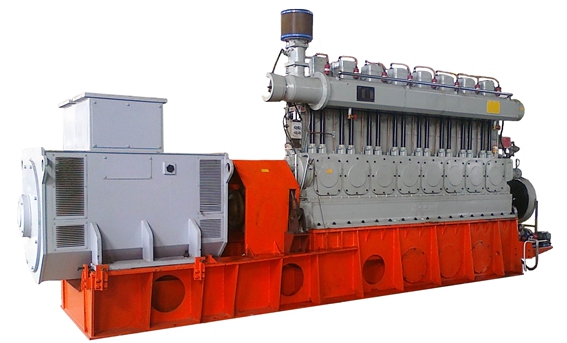水洗工艺
Washing process
因为二氧化碳和硫化氢在水中的溶解度比甲烷大,所以水洗不但可以去除二氧化碳,还可以去除硫化氢。此吸收过程是纯粹的物理反应。通常沼气通过压缩后从吸收柱底部进入,水从顶部进入进行反相流动吸收。吸收了二氧化碳和硫化氢的水可以再生循环使用,可以在吸收柱中通过减压或者用空气吸脱再生,当水中的硫化氢浓度比较高的时候,一般不推荐使用空气吹脱,因为水很快又被硫污染。如果有废水可以利用,不推荐对水进行再生。
Because the solubility of carbon dioxide and hydrogen sulfide in water is greater than that of methane, water washing can not only remove carbon dioxide, but also remove hydrogen sulfide. This absorption process is a pure physical reaction. Generally, biogas enters from the bottom of the absorption column after compression, and water enters from the top for reverse flow absorption. The water absorbing carbon dioxide and hydrogen sulfide can be recycled and recycled. It can be regenerated by decompression or air absorption in the absorption column. When the concentration of hydrogen sulfide in the water is relatively high, air blowing is generally not recommended, because the water is quickly polluted by sulfur. If there is waste water available, regeneration of water is not recommended.
聚乙二醇洗涤工艺
Polyethylene glycol washing process
聚乙二醇(Selexol)洗涤和水洗一样,也是一个物理吸收过程。主要成分为二甲基聚乙烯乙二醇。和在水中一样,二氧化碳和硫化氢在Selexol中的溶解度比甲烷大,不同之处是需要的Selexol的量比水减少,更加经济和节能。另外水和卤化烃(填埋场沼气中的成分)也可以用Selexol洗涤去除。Selexol可以再生重复使用,可以使用水蒸汽或者惰性气体(净化后的沼气和天然气)吹脱Selexol中的元素硫,但是不推荐使用空气。
Polyethylene glycol (selexol) washing is a physical absorption process just like water washing. The main component is dimethyl polyethylene glycol. As in water, the solubility of carbon dioxide and hydrogen sulfide in selexol is higher than that of methane. The difference is that the amount of selexol needed is less than that of water, which is more economical and energy-saving. In addition, water and halogenated hydrocarbon (components of landfill gas) can also be removed by selexol washing. Selexol can be regenerated and reused, and water vapor or inert gas (purified biogas and natural gas) can be used to blow off elemental sulfur in selexol, but air is not recommended.
膜分离工艺
Membrane separation process
膜法分离主要有两种方法:一种是膜的两边都是气相的高压气体分离;另一种是通过液体吸收扩散穿过膜的分子的低压气相-液相吸收分离。
There are two main methods of membrane separation: one is the high-pressure gas separation with gas phase on both sides of the membrane; the other is the low-pressure gas-liquid absorption separation of molecules passing through the membrane by liquid absorption diffusion.

1)高压气相分离
1) High pressure gas phase separation
压缩到36×105Pa的沼气首先通过活性炭床以去除卤化烃和硫化氢,接着便通入滤床和加热器。膜是由醋酸纤维素制成,可以用来分离像二氧化碳、水蒸汽和残留的硫化氢等极性分子,它有一定的选择性,即在不同的区域吸收硫化氢和二氧化碳,但不能分离甲烷中的氮。经验表明,膜可以持续使用三年,在使用一年半后,因为萎缩的缘故,膜的渗透性会减少30%。
The biogas compressed to 36 × 105Pa first passes through the activated carbon bed to remove the halogenated hydrocarbon and hydrogen sulfide, and then flows into the filter bed and heater. The membrane is made of cellulose acetate, which can be used to separate polar molecules such as carbon dioxide, water vapor and residual hydrogen sulfide. It has certain selectivity, that is, it absorbs hydrogen sulfide and carbon dioxide in different areas, but it can not separate nitrogen in methane. Experience has shown that the membrane can last for three years, after one and a half years of use, the permeability of the membrane will be reduced by 30% due to shrinkage.
2)气相-液相吸收膜分离
2) Gas liquid absorption membrane separation
气相-液吸收膜工艺近年才被用在yl6809永利上,其实质是沼气中的硫化氢和二氧化碳分子穿过一个多孔的熟睡膜在液相中被吸收去除。从下方进入的气体,其中的硫化氢和二氧化碳分子能够扩散穿过膜,然后被相反方向流过的液体吸收,吸收膜在一个标准大气压下工作。在25℃到35℃,可以非常有效地把沼气中的硫化氢浓度从2%减少到小于250ppm,液相的吸收剂可以用NaOH溶液。吸收了硫化氢的NaOH溶液可以应用于水处理中以去除重金属。二氧化碳可以通过胺溶液作液相去除,胺溶液可以通过加热再生,释放处纯净的二氧化碳可作工业应用。
The gas-liquid absorption membrane technology has been used in biogas purification in recent years. Its essence is that hydrogen sulfide and carbon dioxide molecules in biogas are absorbed and removed in the liquid phase through a porous sleeping membrane. The hydrogen sulfide and carbon dioxide molecules in the gas entering from the bottom can diffuse through the membrane, and then be absorbed by the liquid flowing in the opposite direction. The absorption membrane works at a standard atmospheric pressure. From 25 ℃ to 35 ℃, the concentration of hydrogen sulfide in biogas can be effectively reduced from 2% to less than 250PPM, and NaOH solution can be used as absorbent in liquid phase. The NaOH solution absorbed hydrogen sulfide can be used in water treatment to remove heavy metals. Carbon dioxide can be removed by amine solution as liquid phase. Amine solution can be regenerated by heating. The pure carbon dioxide released can be used in industry.
